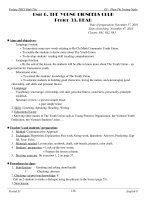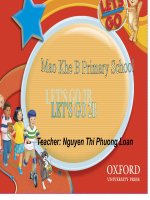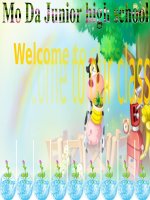ENGLISH 9 W 20 P37-38 UNIT 6 GS LISTEN & READ SPEAK
Bạn đang xem bản rút gọn của tài liệu. Xem và tải ngay bản đầy đủ của tài liệu tại đây (136.05 KB, 8 trang )
Date of preparing: 26/12/2019
Period 37
UNIT 6 : THE ENVIRONMENT
LESSON 1: Getting started, Listen and read
A.Objectives:
1. Aims: By the end of the lesson, students will know more about the environment
problems and the solutions.
2. Practice skill:
- Practice listening, reading, writing and speaking skill.
3. The knowledge needs to get:
+ Standard knowledge: The environment problems and the solutions.
+ Advanced knowledge: Talk about the things which protect the environment.
4. Basic language: Conditional sentence type 1
-Vocabulary: -deforestation, garbage dump, pesticides, shore, spoil, sand, rock.
5. Attitude:- Help ss to have good consciousness in order to will know more
about the environment problems and practice reading for details about cleaning
the beach.
B. Teaching- aids:
Lesson plan, textbooks, pictures, poster. CD, computer.
C. Methods:
- Model-Talk-Practice, individual work, pair work
- Some techniques can be used: Brainstorming, Matching, Prediction,
Comprehension Questions.
D. Procedure :
I.Organization: ( 1 minute)
- Greeting: Good morning!
- Who’s absent today?
Class
9A
9B
9C
Date of teaching
2/1/2020
31/12
31/12
Absent students
Steps/ Activities
II. WARM UP
(3 minutes)
Brainstorming
- Ask students to think of the environtmental
problems in their city.
- Get students to go to the board and write down their
ideas.
* Possible answers:
- the destruction of the forests.
- rubbish/ garbage/ trash.
- smoke from cars, motorbikes...
- smoke from factories.
III. NEW LESSON (38minutes)
Step 1. Pre Reading :
1. Vocabulary :
1. ( explanation: the destruction of the forests).
2. ( picture )
3. ( picture )
4. ( picture )
5. ( synonym ).
6. (translation)
Sts : - listen.
- listen and repeat (chorally then individually).
- copy.
* Checking vocabulary:
what and where.
- Write the works on the board, put one in each circle.
- Have students repeat the words in chorus, then rub
out word word by word but leave the circle.
- Go on until all the words are rubbed out.
- Point to each circle and ask students to repeat
chorally the English words.
- Ask students to go to the board and write the words
again in their correct circles.
Content
environmental problems in
our city
dirty street
pollution
air
1. Vocabulary :
- deforestation ( n ):
sự tàn phá
rừng.
- garbage dump ( n ): đống
rác
- dynamite fishing ( n ):
việc đánh bắt cá bằng
thuốc nổ
- spraying pesticides ( n ):
việc phun thuốc diệt
sâu bọ.
- disappointed ( by/ about/ at
something ) : (adj):
thất vọng, buồn
rầu
- sewage ( n ):
nước thải, nước
cống
2. Getting Started :
* Answer keys:
- Picture a: air pollution.
2. Matching
- Picture b: spraying
- Ask students to look at the six pictures on page 47 in pesticides.
their text books.
- Picture c: garbage dump
- Ask them to match the words in the box with the
- Picture d: water pollution.
correct pictures.
- Picture e: deforestation.
- Picture f: dynamite fishing
3. Prediction
3. Listen and Read
- Ask students to keep the books closed.
a. Guessing :
- Set the scene: Mr. Brown is talking to some
Where are they going to
volunteer conservatioists. Guess the place where they
are going to work.
- Give students 1 minute to guess.
- Give feedback.
Step 2. While Reading :
1. Reading and Checking
- Ask students to open their books and read the text
on page 47 - 48.
- Let students check their prediction.
- Give feedback
2. Matching
- Ask students to match the namees in column A with
the activities in column B ( exercise 2a on page 48 ).
- Ask them to read the text again and work in pairs to
match.
3. Comprehension Questions.
- Ask students to work in pairs to answer the
questions on page 48 ( exercise 2b ).
- Let students read the text again and answer the
questions.
- Give feedback.
- Ask students to work in closed pairs.
Step 3. Post Reading :
- Ask Ss to work in group of three to four and discuss
questions 6 and 7 in the book . Write the questions on
the board :
1. Have you ever done anything similar ? If yes , what
did you do ? Where did you do it ?
2. If the pollution continues , what might happen ?
work ?
Answer keys:
- The conservationists are
going to clean the beach.
b. Matching :
Answer keys:
Group 1 - f. walk along the
shore.
Group 2 - e. check the sand.
Group 3 - b. check among
the rock.
Mr. Jones - a. collect all the
bags and
take them to the
garbage dump.
Mrs. Smith - c. provide the
picnic
lunch for everyone.
Mr. Brown - d. give out the
bags.
c. Question :
Answers:
1. The speaker is Mr.
Brown .
2. The listeners are
( members of ) the volunteer
conservationists.
3. They are on the beach.
4. They are going to clean the
beach .
5. If they work hard today,
they will make the beach
clean and beautiful again
soon.
4.Discussion
6. Yes, I have. We clean our
school/ the park/ street. We
collected the rubbish and take
them to the garbage dump.
All of people have to protect
environment in save pollution of
rivers, recycle spams, have
- Call on some Ss to answer the questions loudly in
front of class.
IV. SUMMARY (1 minutes)
- Reading about the environment problems and the
solutions.
- Listening for details to complete the notes.
V. HOMEWORK (2 minutes)
- Write the answers of the questions (Read b ) in the
notebook .
- Prepare the new lesson: Speak.
sense about environment
protection problem, educate all
of student when they are at
school, don't litter indiscrimina,
hang panner, propagandize
about sense of environment
7. If the pollution continues,
the environment around us
won’t be good and it wiil be
harmful to our health, our
life.
5. Homework :
* Evaluation :
.....................................................................................................................................
.....................................................................................................................................
.....................................................................................................................................
.....................................................................................................................................
.....................................................................................................................................
.....................................................................................................................................
Period 38
Date of preparing:26/12/2019
UNIT 6 : THE ENVIRONMENT
LESSON 2 : Speak
A.Objectives:
1. Aims: By the end of the lesson, students will be able to persuade their friends to
protect the environment.
2. Practice skill:
- Practice listening, speaking skill.
3. The knowledge needs to get:
+ Standard knowledge: to persuade their friends to protect the environment.
+ Advanced knowledge: Talk about the things which protect the environment.
4. Basic language:
-Vocabulary: - prevent, reduce ( v ): wrap ( v ):
faucet ( n ): leaf ( n ) leaves
5. Attitude:- Help ss to have good consciousness in order to persuade their friends
to protect the environment.
B. Teaching- aids:
Lesson plan, textbooks, pictures, poster. computer.
C. Methods:
- Model-Talk-Practice, individual work, pair work
- Some techniques can be used: Jumbled words, Matching, Questionaire,
Exhibition.
D. Procedure :
I.Organization: ( 1 minute)
- Greeting: Good morning!
- Who’s absent today?
Class
9A
9B
9C
Date of teaching
3/1
2/1
2/1
Absent students
Steps/ Activities
Content
II. WARM UP (5 minutes)
Key :
Jumbled words:
uaderpse
- Divide the class into two teams. Students from two
beaargg
persuade
teams go to the board and write the correct words.
roderpvi
garbage
- The team which writes more correct words first wins lupotilon
provide
the game.
duproce
pollution
paispoidedn produce
t
diasapointed
III. NEW LESSON (35minutes)
1. Vocabulary :
Step 1. Presentation :
- prevent ( v ):
1. Vocabulary :
ngăn chặn, phòng
1. ( translation )
chống
2. ( example) : last time, this shirt cost 50.000 dongs. - reduce ( v ): giảm, làm
Now it costs 30.000 dongs. What
giảm
happens?.
- wrap ( v ):
bao
3. ( mime )
bọc
4. ( picture )
- faucet ( n ):
vòi
5. ( realia )
nước
Sts : - listen.
- leaf ( n ) - leaves ( pl ):
- listen and repeat (chorally then individually).
ngọn lá
- copy.
* Checking vocabulary:
Slap the board .
- Put the new words all over the board, each word in a
circle.
- Call two students or two teams ( 6 students for each
team ) to the front of the class. Ask them to stand at
an equal distance from the blackboard.
- Teacher calls out some of the new words in
Vietnamese in a loud voice, the two students must run
forward and slap the word on the blackboard. The one 2. Matching :
who slaps the right word first is the winner.
* Form:
- Ask 2 more students to come forward, etc...until all -I think you should
the words are slapped.
-Won’t you
2. Matching
-It would be better if you
- Ask students to complete the expressions in column -Can I persuade you to
A by using one of the lines in column B ( page 49 )
INF
then compare with their partners.
-Why don’t you
- Have students match the lines in column B with an
-Why not
expression in column A so that they have sentences of -What / how about + V - ing
persuasion.
- Ask Sts to give the form of persuasion.
Step 2. Practice :
1. Practice speaking
- Each students calls out one of their sentences until
all sentences are finished.
* Example:
S1: I think you should use banana leaves to wrap
food.
S2: Won’t you use banana leaves to wrap food?
S3: Why don’t you turn off the lights before going to
bed?
S4: It would be better if you go to school or go to
work by bike.
S5: Can I persuade you to check all the faucets before
going out?
S6: Why not put garbage bins around the school yard?
S7: I think you should use public buses instead of
motorbikes?
S9: ...
2. Questionaire
- Let students work in pairs to answer to the questions
in the questionaire.
- Give feedback, teacher can write some possible
answers on the board so that weak students can
follow.
- Ask students to practice asking and answering.
- Ask the whole class to work in pairs.
Step 3. Production :
Exhibition:
- Divide the class into 4 groups, each group has a
secretary. Ask them to discuss the question: “what do
you do to protect the environment ? ”.
- The students in groups have opinions, the secretary
* Use: Express persuasion
3. Speak :
Possible answers:
1. How can we save paper?
* I think you should recycle
used paper, newspapers.
* Why don’t you use
banana leaves for
wrapping?
* Won’t you write on both
sides of the paper?
2. How can we use fewer
plastic bags?
* How about cleaning and
reusing them?
* Why not use paper bags
instead of plastic bags?
3. How can we reduce water
pollution?
* It would be better if you
don’t throw wastes and
garbage into streams, lakes
or rivers and even ocean.
4. How can we prvent
littering?
* I think we should put
garage bins around the
writes down.
- Get students to use the ideas in exercise 3a, b.
- After finishing, the students stick the 4 poster on the
wall. They can go around the class and read 4 posters.
- Give feedback.
IV. SUMMARY (1 minutes)
- Speaking to persuade people to protect the
environment .
V. HOMEWORK (2 minutes)
- Write a short paragraph to persuade people to
protect the environment .
-Prepare the next lesson: Listen
school yard.
* Why don’t you throw all
garbages in waste bins.
5. How can we reduce air
pollution?
* Can I persuade you to go
to school by bike.
* Why not use private
vehicles less?
6. How can we reduce the
amount of garbage we
produce?
* Won’t you try to reuse
and recycle things.
4. Homework :
* Evaluation :
.....................................................................................................................................
.....................................................................................................................................
.....................................................................................................................................
.....................................................................................................................................









